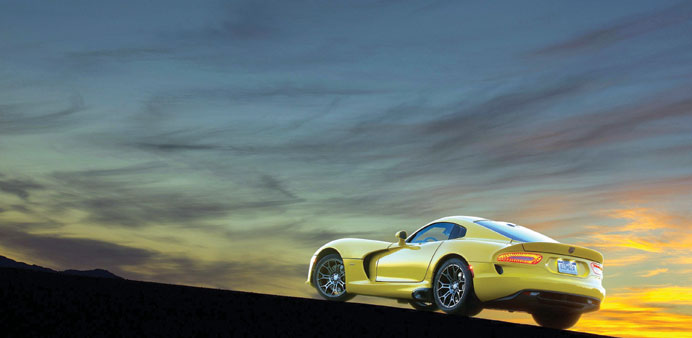The 2013 SRT Viper returned after a three-year absence with a complete redesign billed under Chrysler’s newly spun-off SRT, or Street and Racing Technology, brand.
By Susan Carpenter
The 2013 SRT Viper is the sort of car that should come with disability insurance for neck injuries — not only for the whiplash drivers could experience attempting to max out its 206mph top speed, but for its many admirers who rubberneck, pivot and crane to get a better look.
In the weekend I spent with the dead-sexy, fifth-generation snake, men literally hung out their windows to take pictures. Police cars routinely tailgated and sidled me. Invariably, when I passed a BMW 3 Series on the freeway, that same car would speed up to pace me and smile, to which I responded as one would expect from a Viper — with a wave and a stomp of the accelerator.
The attention is understandable. Curvy in all the right places, if the SRT flagship were any more voluptuously alluring, it would have to be renamed Scarlett Johansson.
Returning after a three-year absence with a complete redesign billed under Chrysler’s newly spun-off SRT, or Street and Racing Technology, brand, the newest incarnation Viper is skinned, for the first time, with aluminium door panels and lightweight carbon fibre on the hood, roof and deck lid — all of which contributed to a 100-pound weight savings over the fourth-generation model, which went out of production in 2010.
Even the Viper logo has been redesigned with more dramatically bared fangs, a menacing graphic that graces the one area of the car other drivers are most likely to see: its back end.
The $99,390-plus Viper (price in the US) uses a slightly more powerful 8.4-litre V-10 engine mounted mid-front under a hood so dramatically elongated I had to jack up the seat just to see. A new double-bubble roof ensures that taller drivers won’t inadvertently scrape their hair on the headliner. It’s designed to accommodate helmets for the Viper’s natural environment: slithering through S curves on a track.
Its pipes are as hypnotising as a snake charmer’s. The exhaust begins with an enticing grumble at idle. By 4,000 rpm, it’s become a thrum that lodges in the base of one’s brain. By 6,000 rpm, when the engine is approaching peak horsepower, it reaches its most musical, easily heard pitch. The exhaust is literally just outside the doors. It ports to the sides instead of the back.
A street-legal race car, the Viper likes nothing more than speeding into a corner at 5,000 rpm, when it reaches peak torque of 600 foot-pounds — the most of any naturally aspirated sports car in the world.
Tuned for extreme performance, with a new aluminium X brace under the hood to increase rigidity in the turns, a new dual-mode suspension system and a first-for-a-Viper stability control system, it’s a machine begging to be thrashed.
For show-pony street driving, the suspension is a bit rough, even in its softer street mode, but it isn’t designed to soak up road imperfections. Whether it’s rolling on the track or poorly maintained asphalt, the suspension’s intent is to keep the car hunkered. And it does. If the Viper were any more planted in the corners, it would be a tree.
Poised as the chassis is, no one likes to be thrown around a cabin, especially one as expensive as the Viper. While drivers have a leather steering wheel to grip, the passenger has a grab rail mounted to the centre console. Both occupants are held in place with new high-performance racing seats shelled in Kevlar and industrial-strength side bolsters that keep passengers as grounded as the car in high-speed turns.
The Viper is so wide and low-slung for handling that getting in and out of the car is an art form. For 2013, the seats are situated an inch lower than the last model. Any lower, and I’d feel like a dog swiping his hindquarters on the grass.
The legroom has likewise expanded dramatically, by 3 and half inches — a feat enabled by pushing the cabin even further back in the Viper’s long and low chassis.
Speed signs aren’t a warning in the Viper. They’re a dare to double them. A coiled snake tightly wound for attack, its acceleration is instantaneous, though it requires some double leg work to tap into its power.
The Viper is the rare supercar to use a manual transmission rather than paddle shifters. Being a motorcyclist, I prefer the engagement of operating a clutch with a foot and a shifter with the hand while also managing the steering, even if paddle shifters are more convenient and faster-acting. A Viper standard, the six-speed manual has been updated with a shorter throw of the shifter stick, though the clutch feels extraordinarily long.
The new Viper includes steering wheel controls for the usual features, such as audio and Bluetooth, as well as something less usual: It’s outfitted with a launch-control switch for quicker starts, the results of which are displayed on the dashboard.
Every time the car launches from a dead stop, it starts a timer for its 0 to 60 acceleration time. The dash can also be customised to display quarter-mile times, braking distance, top speed and g-force, all of which can be stored and bragged about — with proof — later.
Averaging 15 mpg combined, fuel economy isn’t as abysmal as one would expect for a car that bites pretty much anything else on the road. Even thinking about fuel economy while driving the Viper reminds me of my interview with Evel Knievel shortly before he died, when I inquired about the fuel economy of his motorcycle-toting RV. “If you have to ask,” he told me, “you can’t afford it.”
Most people, of course, can’t, which only adds to the Viper mystique. Some cars are deserved icons. — The Orange County Register/MCT
*** (Price and technical specifications may vary in locally available models.)
In a nutshell
Powertrain: All-aluminum, 8.4-litre, mid-front V-10, OHV, rear-wheel-drive, 6-speed manual transmission.
Horsepower: 640 at 6,200 rpm
Torque: 600 pound-feet at 5,000 rpm
Top speed: 206 mph
0 to 60 acceleration: low 3-second range
Length: 175.7 inches
Wheelbase: 98.8 inches
Width: 76.4 inches
Height: 49.1 inches
Ground clearance: 5 inches



